The rain was torrential last Tuesday and our windscreen wipers were going nineteen to the dozen as we drove down the M4. Familiar yellow signs guided us through Windsor…….
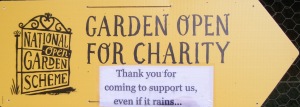
…..and in spite of the weather the garden gate was wide open at Frogmore. Open for charity just 3 days a year, they have been opening for the NGS for a noble 71 years. The rain did not seem to deter the visitor and many hundreds who had purchased pre-booked tickets braved the weather.
I was overwhelmed with the unexpected welcome awaiting me. Heather, County Organiser extraordinaire for Berkshire, Trustee AND Deputy Chairman of the NGS, was waiting for me and with her big smile she held up the notice she had prepared:

We joined the garden history tour and gathering under a huge old crusty Indian bean tree, Catalpa bignonioides, we stood for a sobering reflective minute silence remembering the victims of the recent terrorist attack.

With the realisation that there really is somebody reading my blog, I felt compelled to concentrate. Our guide began her tour in front of the mausoleum and looking up at the grey building against a gloomy sky I am reminded of a poem by John Betjeman:
‘Oh Lord Cozens Hardy Your mausoleum is cold,’
It is cold, and wet, but no Lord C-H lies here. Built just four days after Albert’s death in 1861 it is now reserved for members of the Royal family. Prince Edward, Duke of Windsor and his Duchess are laid to rest under an old oak tree.

Frogmore House was acquired by the Royal Family in 1792 when George III bought it for his wife Queen Charlotte. They had 15 children, 13 of whom survived to adulthood and it became a retreat for the Queen and her unmarried daughters. Queen Charlotte had a passionate interest in botany which had begun when she lived at Kew in 1770s. She was instructed by Sir James Edward Smith the principal founding member and President of the Linnean Society of London.
Designed at the time of the ‘picturesque’ movement, the garden is not so much about borders of flowers but of trees and shrubs; in fact over 4,000 specimens many of which were introduced by Queen Charlotte herself and later by Queen Victoria.
There are of course some flowers and the lovely Mock Orange, philadelphus is standing up well to the rain.

and so too are the pink flowers of the black elder, sambucus nigra.

This climber from Chile hydrangea serratifolia is also in flower and it brightens a shady tree growing upwards effortlessly without any apparent means of support.

The trees are well looked after, have plenty of space and are clearly labelled. It did take me awhile to identify this one,
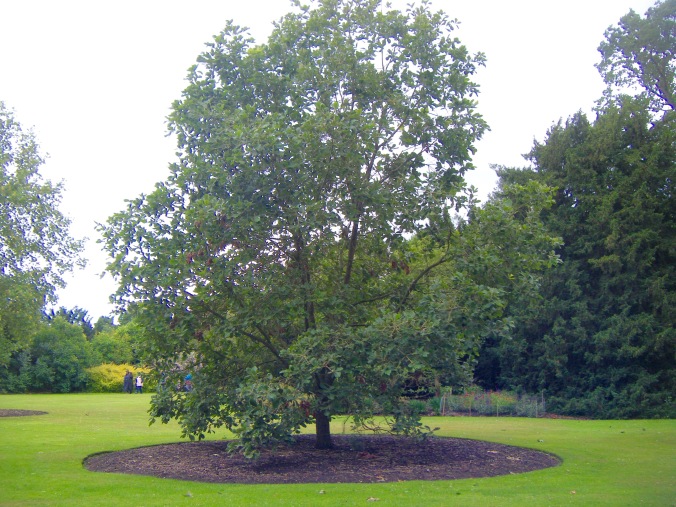
too obvious the label was at eye level; it is the Korean Oak sometimes called the Japanese Emperor Oak, Quercus dentata.

There are several types of oak and I love the multi branched Cypress Oak, quercus robur f. fastigiata,

and the leaves of the Pin Oak, Quercus palustris, bend gracefully down.

The lakes were dug and the mounds constructed when the garden was laid out at the end of the eighteenth century. The water in the lakes is run off from the surrounding farmland and there is plenty of it. Paths weave a circuitous route around the 40 acres. Stepping over the iron bridge,

we glimpse a view of the house beyond the wild flower meadow.
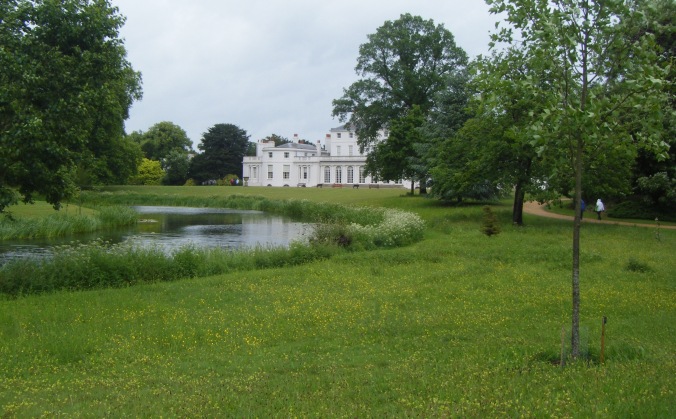
This was Queen Victoria’s favourite part of the garden. Here she would drive the short distance from the house in pony and trap accompanied by the faithful John Brown, to take tea served by her Indian servants.
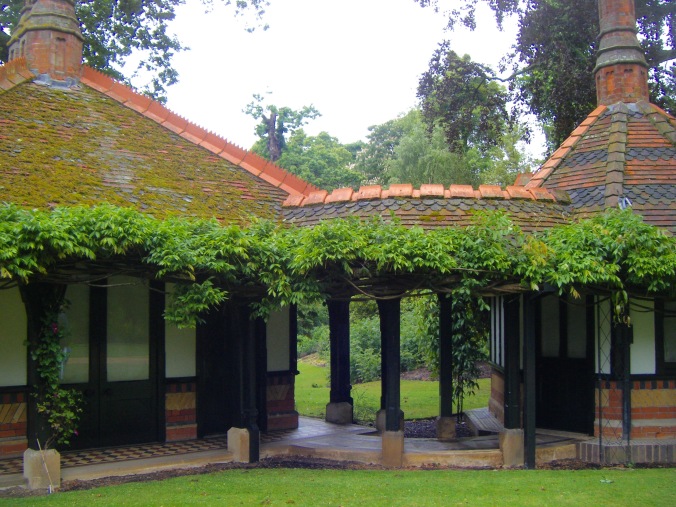
(Photo with acknowledgement from https://www.royalcollection.org.uk/visit/frogmorehouse/what-to-see-and-do/the-garden)

Queen Victoria feared the crowds, but she was well away from them at Frogmore. By the house there is a developing scene, but it is only the foxgloves jostling for position eager to see a royal visitor.

We sympathise with the guide when she says the front of the house on the north side is more like the back with a functional entrance…

…whilst the back has an architecturally more pleasing frontage. It was James Wyatt’s first commission, and the one to launch his career.
A pair of large majestic urns stand on the lawn.

The view from here is indeed ‘picturesque’; the formal foreground leads to the serpentine lake and park in the middleground which then connects to the natural scenery in the far background.
The sky still looks uncertain but thankfully umbrellas have now been put away.

Following the path to the west of the house we pass the shrub border where we admire the bright green seed pods of the ivory-flowered bladdernut, staphylea colchica.
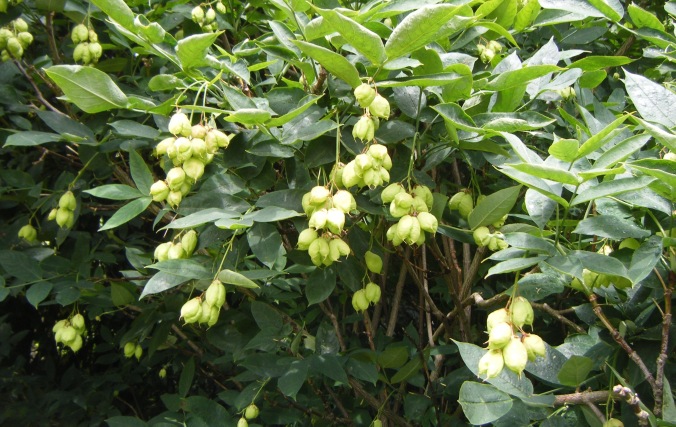
Over a small bridge well clad with virginia creeper. parthenocissus quinquefolia,

we arrive at the Gothic Ruin. Built as a ‘ruin’ and designed by James Wyatt it has stained glass but was damaged recently by a falling tree. This is where Queen Charlotte and her daughters would take their tea and Queen Victoria would enjoy breakfast. Just inside and discreetly placed is a dog bowl of water ready for a passing present day corgi.

A visitor has already asked if the Queen’s children ever played on the water and the guide points out that this is the very spot where the young princes would launch their boats.

Across the lake a driftwood horse flicks it’s tail; crafted by Heather Jansch the sculpture is in fact bronze.
Moving in a westerly direction we come to the Indian Kiosk installed to celebrate the relief of the Siege of Lucknow in 1857; this is the site thought to have been Queen Charlotte’s flower garden. She not only learnt botany but was also instructed in botanical illustration by both Francis Bauer and Margaret Meen.

At the end of our very informative tour we hurry over to the lawn where we find a gathering of nurses and their families from the Queen’s Nursing Institute. They had travelled here from far and wide, Rosie for example set off at 5am from Preston in Lancashire.
Head Gardener Neil leans nonchalantly on the sun dial (which came from Claremont House) while Heather makes a short speech praising the nurses as the unsung heroes of the community and explained that it was the idea to raise funds for QNI that was the inspiration behind the foundation of the NGS ninety years ago.
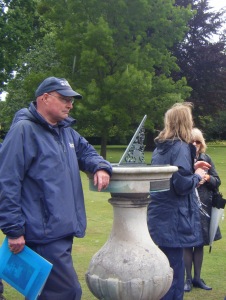
Queen Victoria gave her patronage to the institute then known as the ‘Jubilee Congress of District Nursing’, so it was only fitting that the group be photographed in front of the house she so loved.
One nurse told me that it was great to have the link with the NGS because when visiting patients in their homes, conversations would inevitably turn to gardening.
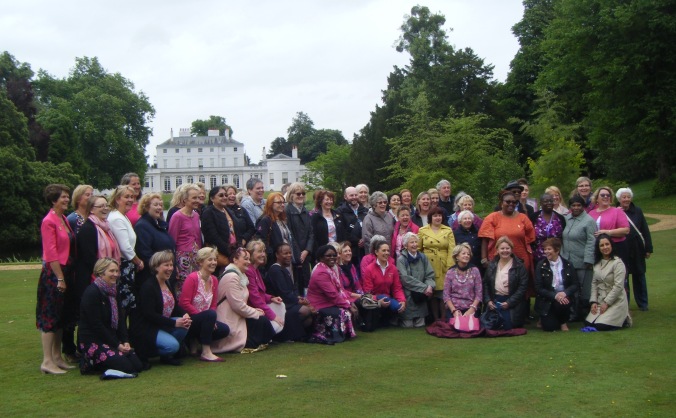
Not far from the group is the spectacular flower of the Tulip tree, liriodendron tulipifera it is a large tree but nearby grows a smaller specimen presented by the NGS in 2005.

Frogmore House is open today and it is an opportunity to see inside. We wander back over a small bridge,

and another,

catching sight again of the gothic ruin.

The house contains a large collection of botanical books once belonging to Queen Charlotte, and her floral interest is displayed throughout the interior. She commissioned Mary Moser, the renowned 18th-century flower painter and one of the Royal Academy’s founding women, to decorate one of the principal rooms to resemble an arbour open to the skies. We are not allowed to photograph inside so I have borrowed an oil on canvas © Royal Academy of Arts, London. Photographed by John Hammond.:

Back outside it is brightening. From the lawn in front of the house we can see a building perched on the hill, it is thought to be inspired by Vanbrugh’s Temple of the Four Winds at Castle Howard.
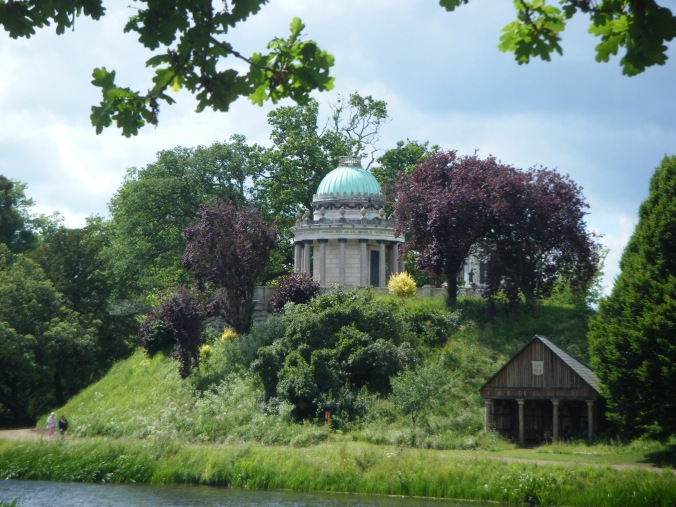
It has been such an interesting day. Every garden has it’s own history and none more so than this one. We have followed winding paths, viewed beautiful buildings in glorious grounds, all set in a very watery landscape. We have also enjoyed the good company of others. The sky is really blue now,
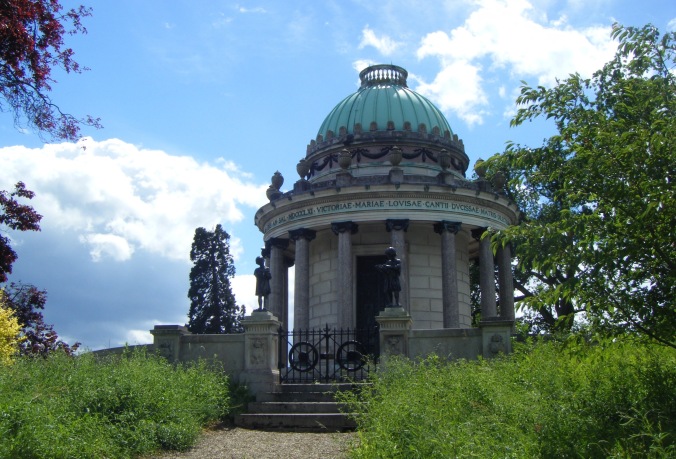
it is just the cherry on the tree.

Surely one of your best.. a very good read, thank you kindly.
LikeLiked by 1 person
One of your best and halfway! Well done I always love your blog! Please can I order one of the book? See you in Sussex soon! Love Pattyxx
LikeLiked by 1 person
Thank you for supporting me and looking forward to another trip to Sussex.
LikeLike
Half way there, congrats! I thought the photo of the tulip tree just stunning
From Fi
LikeLiked by 1 person
Thank you. Tulip trees are just magical
LikeLike
I always look at your blog posts and have enjoyed each and every one of them. It is the closest I will probably ever get to be to a garden in England. Your photos and descriptions bring them to life. I like to see what is hardy in different areas etc.
This garden I will think about when I read historical novels and read about their walks/rides through the garden.
I find it very interesting to see American trees in English gardens. I love the Tulip tree. It is the State Tree for Indiana, where I live.
LikeLiked by 1 person
How really interesting. It is amazing that some living all the way in Indiana is reading my little old blog. Thank you for following.
LikeLike
I just love your blogs and learn such a lot . Can’t believe you have done 45 just brilliant.
LikeLiked by 1 person
Thank you for kind words I can’t really believe it either!
LikeLike
You so deserved the sunshine by the end of your visit. And what a camera and a photographer – that amazing photo of the Indian kiosk and the tree in the foreground – it’s all in focus! Your photos give so much pleasure along with your captions. Roll on the next 45, but not too quickly please as life won’t be the same without your blogs dropping into my inbox.
LikeLike
45 gardens, goodness what dedication. Frogmore looks wonderful even in the rain. I have never seen Hydrangea serratifolia, how amazing; it doesn’ t look anything like a hydrangea.
LikeLike
Hi Julia
I was about to congratulate you too on reaching your half way goal! Well done. Richard and I are reading everyone and look forward to them.
We are visiting gardens in Northumberland, off to see Alnwick tomorrow.
Rosemary
Sent from my amazing iPad!
LikeLike
Fascinating as always Julia- thankyou. Congrats on reaching the half-way mark!
LikeLike
Reblogged this on The Garden Gate is Open and commented:
I thought we might enjoy a revisit to Frogmore ahead of Her Majesty the Queen’s appearance today on Radio 4 Gardener’s Question Time at 3.00pm
LikeLike
Picturesque indeed! A perfect example of one of my favourite words…apparently I called it ‘picture skew’ as a child. Always a precocious reader and very teased by family. How lovely now to be able to sit in bed with a cup of tea and enjoy your beautiful blogs! Keep up the good work…
LikeLike
A great read. And good to hear of Norwich man James Edward Smith as founding President of the Linnaean Soc.
LikeLike
A great read and thanks for the reminder of today’s “Gardener’s Question Time” . Frogmore’s temple on the hill looks a bit more like the mausoleum at Castle Howard than the temple of the four winds?….but maybe the royals feel you can just have too many mausoleum’s in one garden, I liked your Betjeman reference. Lovely oak trees.
LikeLike
Brilliant Julia, I too have read and enjoyed every one of your blogs. Fabulous descriptions, photography and all have been so interesting. Well done.
LikeLike
Julia, fantastic as always and such a joy to read, well done, and I think the book is a wonderful idea!
Sally
LikeLike
um what book?
LikeLike